 Photo ©
Keith Williams
Photo ©
Keith Williams
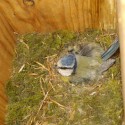
Cold Weather, Warm Nest
Scientists have long studied the role of birds’ nests in avian reproduction, working to illuminate the relationship between nest structures and nesting success. Nests are not just a sturdy vessel in which to lay eggs; they also serve to conceal eggs and nestlings from predators, protect them from the elements, and for some species, nests even help females choose a mate with good genetic qualities. You might think that a stronger, denser nest would naturally result in higher nestling survival, but that’s not always the case. Consider the Mourning Dove: they build a flimsy platform nest which has little insulation value, and yet they are one of the most abundant nesting birds in North America. The Killdeer builds no nest at all, just deposits its eggs directly onto a graveled surface, and they are quite successful breeders. So we know that the relationship is not as straightforward as it might seem.
Researchers in Great Britain recently examined the relationship between local temperatures immediately prior to egg-laying and the thermal properties of the nests which were built, for two species of tits (a close relative of our chickadees). Analysis of temperature data from the seven days prior to egg-laying, when nest-building is most intense, revealed that the temperatures experienced by a female as she is building the nest did influence the amount of insulation that she added to the nest. If the nest was built during a cold period, females tended to add more insulating materials, and vice versa. The authors of this study point out that when tit nests are built during an early spring warming period, this could have negative impacts on success if temperatures drop again. And with climate change likely to make weather patterns less predictable over time, the consequences for nesting birds are unknown.
It remains to be seen whether less-insulated nests will actually result in fewer offspring for birds. So far, study results have been mixed, with some species experiencing a drop in success when insulation is lighter, and some species exhibiting no effects. We are often asked by nest monitors why some nests fail during severe weather and others survive just fine, and there is no simple answer. Perhaps it’s not the severe weather per se that is responsible, but the prevailing balmy weather during the nest-building stage. And perhaps some species are just not as reliant on their nests for insulation as others. It is important to be alert to the vagaries wrought by climate change, and every nest you report to NestWatch gets us closer to understanding whether–and how–nesting success is changing.
Reference: Deeming, D. C., M. C. Mainwaring, I. R. Hartley, and S. J. Reynolds. 2012. Local temperature and not latitude determines the design of Blue Tit and Great Tit nests. Avian Biology Research 5:203–208.
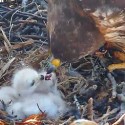
Best Maternal Moments Captured Live
In honor of Mother’s Day, we want to celebrate some exceptional bird “moms” that go the extra mile for their chicks. Watch these intimate moments in the lives of three Bird Cams mothers, each revealing the universal struggles and joys of motherhood. Then, tune in to see what’s happening live on Bird Cams.
- Dinner is Served—Big Red, the fierce Red-tailed Hawk mom, delicately serves up dinner with her powerful beak. When she leaves to get more provisions, the nestlings fall asleep in a warm pile and wait for her to return.
- Protecting the Nest—The formidable Great Blue Heron mom bravely defends her nest from an owl attack. Her bone-chilling screams scare the owl away and quickly bring the male to her side.
- Giving Them Wings to Fly—That moment when your kids are grown and have to make their own way in the world is terrifying, but necessary. Iris, the Osprey mom at Hellgate Canyon, Montana, looks on anxiously as her oldest chick leaves the nest for the first time.
Do you have an “aww” moment captured in a photo or on video? Submit your photos and videos to our Flickr group.
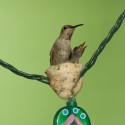
Funky Nests Contest
Whether you find a robin’s nest on a park statue or a hummingbird’s nest on your wind chimes, your picture of a bird nest in a funky place can win big in the Cornell Lab of Ornithology’s Funky Nests in Funky Places contest. With nesting season underway, this contest challenges everyone to get outside and watch nature in even the most unexpected places.
“Just start looking,” says Karen Purcell, who created the contest several years ago as part of the Cornell Lab’s Celebrate Urban Birds citizen-science project. “Past experience has shown us you can find bird nests in the most surprising places. We’ve seen them in helmets, old boots, stoplights, store signs, car tires, clotheslines, mailboxes, potted plants, and even a stuffed moose head!”
The Funky Nests contest began May 1 and lasts until June 15. Entries may be photos, videos, artwork, poems, or stories. You don’t have to be a bird expert or an expert photographer. People of all ages are welcome to participate as individuals or with a class, community center, or afterschool program. Prizes include binoculars, bird feeders, cameras, an iPad, and more.
Check out this video trailer for the Funky Nests contest, and then visit www.FunkyNests.org to enter the contest. Entry deadline is June 15.
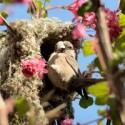
Nest-Searching 101
Nesting season has officially begun, and you just know that there are birds nesting in your yard. The only tricky part is finding them. Well, you wouldn’t drive somewhere new without getting directions first, so why start looking for nests before you’ve read our instructions? We’ve put together a handy tip sheet for finding nests that points out what to look for in the various stages of the nesting cycle. How do you find a nest which is actively being built, or a nest that already has eggs being incubated? NestWatch has you covered; just read our “How to Find Nests” page, and then go outside and quietly observe the activity around you. Patience and good observation skills will be rewarded with an incredible window into the secretive world of nesting birds.
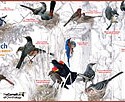
Monthly Winner
At the beginning of each month, NestWatch randomly selects one participant who has entered data that month to receive a copy of the NestWatch Common Nesting Birds of North America poster. This month’s lucky winner is Adam Weber. Congratulations, Adam!